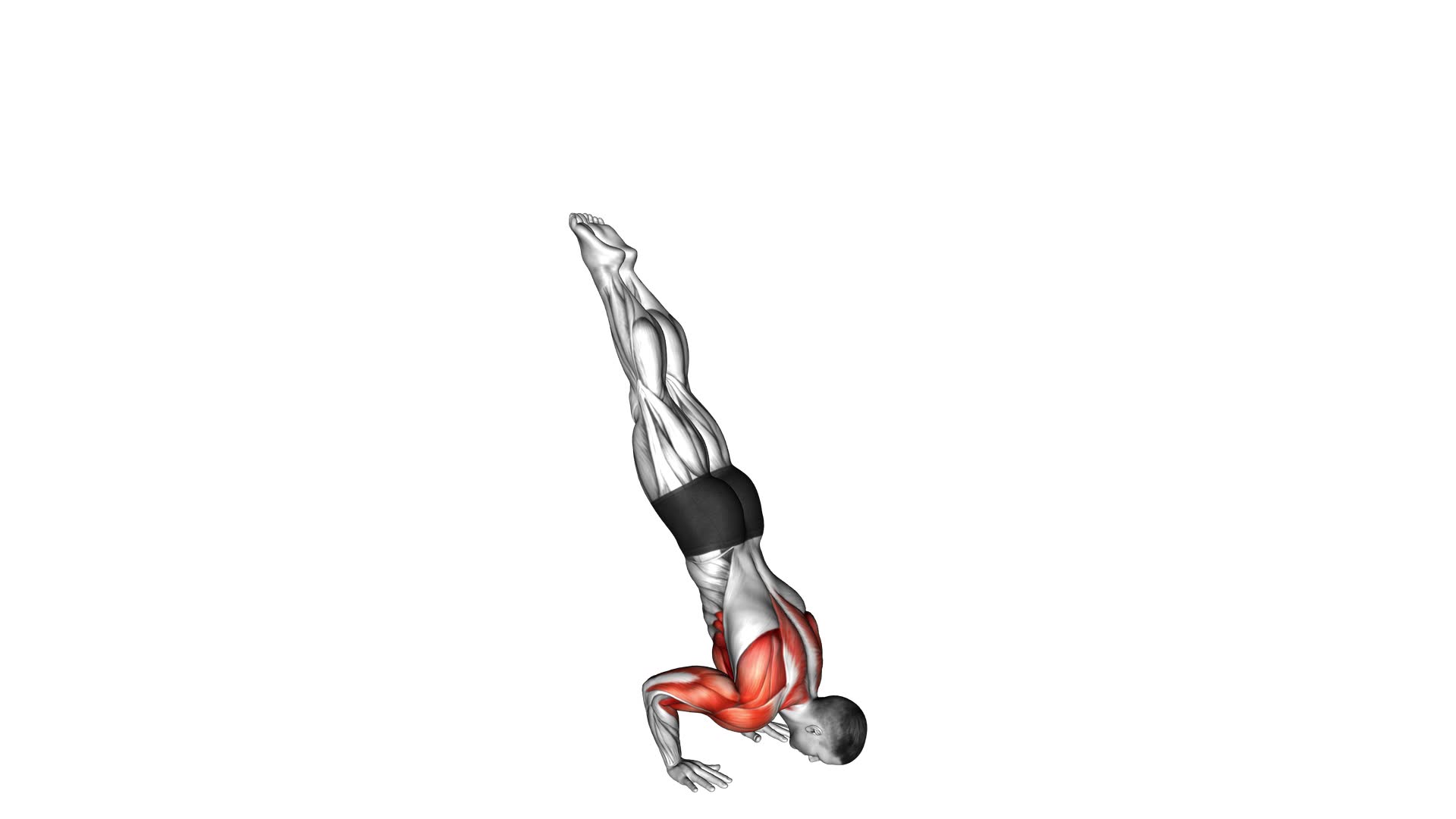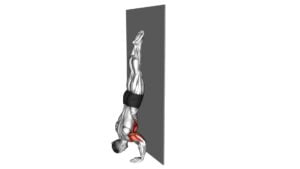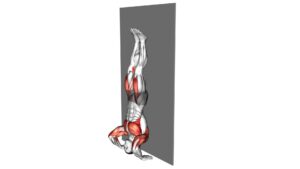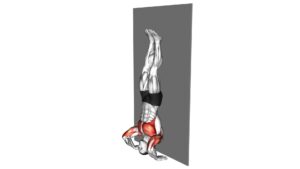Handstand Push-up – Video Exercise Guide & Tips

Looking to take your upper body strength to the next level? The handstand push-up is a challenging exercise that targets your shoulders, triceps, and core. In this video exercise guide, we'll show you proper form, technique, and progressions for beginners.
Watch This Exercise Video
Avoid common mistakes and learn tips for increasing your strength and stability. Get ready to defy gravity and build an impressive upper body with this ultimate bodyweight exercise.
Let's dive in!
Key Takeaways
- Handstand push-ups increase upper body strength and target the shoulders, triceps, and core muscles.
- Proper form and technique include maintaining straight body alignment, engaging the core muscles, lowering the head to the ground in a controlled manner, and pushing back up using the shoulder and tricep muscles.
- Beginners can progress by practicing wall-supported handstand holds, performing pike push-ups, using resistance bands for assistance, and gradually increasing the range of motion.
- Advanced variations of handstand push-ups include straddle handstand push-ups, handstand push-ups with a deficit, one-arm handstand push-ups, and handstand push-ups with added weight.
Benefits of Handstand Push-ups
What are the benefits of incorporating handstand push-ups into your workout routine?
Handstand push-ups are a challenging and effective exercise that can provide numerous benefits for your overall upper body strength and shoulder development. By performing handstand push-ups, you engage multiple muscle groups, including your shoulders, triceps, and core, leading to improved strength and stability.
One of the main benefits of handstand push-ups is their ability to specifically target and strengthen your shoulder muscles. As you lower your body towards the ground and push back up, you engage your deltoids, which are responsible for shoulder abduction and flexion. This exercise can help to increase the strength and size of your shoulder muscles, leading to improved upper body strength and stability.
In addition to shoulder strength, handstand push-ups also offer variations that can target different muscle groups. By changing the hand placement or the angle of your body, you can engage your triceps, chest, and back to a greater extent. These variations allow for a more well-rounded upper body workout.
Now that you understand the benefits of incorporating handstand push-ups into your routine, let's move on to discussing proper form and technique to ensure you get the most out of this exercise.
Proper Form and Technique
How can you perform handstand push-ups with proper form and technique? To ensure that you execute this exercise correctly, there are a few key points to keep in mind.
First, make sure you have the necessary equipment for handstand push-ups, such as a sturdy wall or a set of parallel bars. These will provide stability and support during the exercise.
When positioning yourself for a handstand push-up, start by facing the wall and placing your hands shoulder-width apart on the ground. Kick up into a handstand position, with your heels resting against the wall. Your body should be in a straight line, from your head to your heels. As you lower yourself down, aim to bring your head towards the ground, between your hands.
To add variety to your handstand push-up routine, you can try different variations. For example, you can perform them with your hands wider apart or closer together to target different muscle groups. You can also elevate your feet on a box or bench to increase the challenge.
Remember to maintain proper form throughout the exercise, engaging your core muscles and keeping your body aligned. By following these techniques and incorporating variations, you can achieve optimal results from your handstand push-up workouts.
Progressions for Beginners
To begin your handstand push-up journey as a beginner, start with a few modified variations of the exercise. These beginner modifications will help you build strength and stability while gradually progressing towards the full movement.
One option is to perform pike push-ups, where you start in a push-up position with your hips raised and your body forming an inverted V shape. From there, you can lower your head down towards the ground and push back up.
Another modification is to use a wall for support. Start in a handstand position with your feet resting against the wall, and then lower yourself down towards the ground and push back up.
As you become more comfortable and stronger, you can gradually increase the range of motion and challenge yourself with freestanding handstand push-ups.
It's important to listen to your body and progress at your own pace to avoid injuries.
Now that you have a good understanding of beginner modifications and progressions, let's move on to the next section where we'll discuss common mistakes to avoid when performing handstand push-ups.
Common Mistakes to Avoid
As you progress in your handstand push-up journey as a beginner, it's important to be aware of common mistakes to avoid. By understanding these mistakes, you can prevent injury and improve your form.
One common mistake isn't properly warming up before attempting handstand push-ups. It's crucial to warm up your wrists, shoulders, and core muscles to prevent strains and injuries.
Another mistake is using improper handstand push-up variations. Make sure you're using the correct form and technique for each variation to target the intended muscles and avoid placing unnecessary stress on your joints.
Additionally, avoid arching your back during the exercise. This can lead to lower back pain and strain. Keep your core engaged and maintain a straight line from your head to your heels.
Lastly, don't forget to breathe. Many beginners tend to hold their breath during handstand push-ups, which can limit their performance and make the exercise more difficult. Remember to inhale as you lower yourself down and exhale as you push back up.
Tips for Increasing Strength and Stability
To further enhance your handstand push-up abilities, focus on incorporating exercises that specifically target your upper body muscles for increased strength and stability. By strengthening your upper body muscles, you won't only improve your performance in handstand push-ups, but also reduce the risk of injury.
One of the most effective exercises for increasing upper body strength is the push-up. Start with regular push-ups and gradually progress to more challenging variations such as decline push-ups or diamond push-ups. These variations will target different muscles in your chest, shoulders, and triceps, helping to build the necessary strength for handstand push-ups.
In addition to push-ups, incorporating exercises that target your shoulders and triceps will also contribute to your overall upper body strength. Some effective exercises include shoulder presses, tricep dips, and lateral raises. These exercises will help to strengthen the muscles that are crucial for maintaining stability and control during handstand push-ups.
To further challenge yourself and continue progressing, you can try advanced variations of handstand push-ups. These variations include deficit handstand push-ups, where you elevate your hands on blocks or plates to increase the range of motion, or pike push-ups, where you perform the push-up with your hips elevated in a pike position. These advanced variations won't only increase your strength and stability, but also add variety to your workout routine.
Remember to always prioritize proper form and technique to prevent injury. Start with an appropriate level of difficulty and gradually increase the intensity as you get stronger. With consistency and dedication, you'll be able to improve your handstand push-up abilities and enhance your upper body strength and stability.
Frequently Asked Questions
How Long Does It Usually Take to Master the Handstand Push-Up?
To master the handstand push-up, it usually takes time and consistency.
You need to start with handstand push-up progressions, gradually building strength and balance.
Many people make common mistakes in handstand push-ups, like flaring their elbows or not engaging their core.
By practicing regularly and focusing on proper form, you can improve your handstand push-up skills.
Are Handstand Push-Ups Suitable for People With Shoulder Injuries?
Handstand push-ups can be modified to accommodate shoulder injuries. Common shoulder injuries that may benefit from handstand push-ups include rotator cuff tears, shoulder impingements, and labral tears.
By modifying the exercise, you can still work on building strength in your shoulders without exacerbating your injury. For example, you can perform handstand push-ups against a wall to reduce the amount of weight bearing on your shoulders.
Always consult with a healthcare professional or physical therapist before attempting any exercise with a shoulder injury.
Can Handstand Push-Ups Be Performed Without a Wall for Support?
Yes, handstand push-ups can be performed without a wall for support. To do this, you can start with handstand push-up progressions, such as pike push-ups, to build strength and stability.
Performing handstand push-ups without a wall has its benefits as it requires more core engagement and balance. It can also help improve overall upper body strength, shoulder stability, and body control.
Remember to always practice proper form and start with modified versions if needed.
Are There Any Alternative Exercises That Can Help Build Strength for Handstand Push-Ups?
Looking to build strength for handstand push-ups?
There are alternative exercises that can help you achieve your goal. These exercises focus on building upper body strength and stability, which are essential for performing handstand push-ups.
Some examples include pike push-ups, wall-assisted handstand push-ups, and dumbbell shoulder presses.
These modifications are great for beginners as they allow you to gradually increase the difficulty level and work your way up to full handstand push-ups.
How Often Should Handstand Push-Ups Be Incorporated Into a Workout Routine for Optimal Results?
For optimal results, it's important to incorporate handstand push-ups into your workout routine regularly.
Start with handstand push-up progressions to build strength and gradually increase the intensity.
Aim to do them at least 2-3 times a week, allowing for adequate rest and recovery.
Remember to focus on proper form and technique to avoid common mistakes in handstand push-ups.
Consistency and proper progression are key to achieving your goals.
Conclusion
In conclusion, handstand push-ups are a challenging yet beneficial exercise for building strength and stability.
By maintaining proper form and technique, beginners can gradually progress and avoid common mistakes.
Increasing strength and stability can be achieved through consistent practice and incorporating variations into your routine.
Remember to always prioritize safety and listen to your body's limits when performing this exercise.

Author
Years ago, the spark of my life’s passion ignited in my mind the moment I stepped into the local gym for the first time. The inaugural bead of perspiration, the initial endeavor, the very first surge of endorphins, and a sense of pride that washed over me post-workout marked the beginning of my deep-seated interest in strength sports, fitness, and sports nutrition. This very curiosity blossomed rapidly into a profound fascination, propelling me to earn a Master’s degree in Physical Education from the Academy of Physical Education in Krakow, followed by a Sports Manager diploma from the Jagiellonian University. My journey of growth led me to gain more specialized qualifications, such as being a certified personal trainer with a focus on sports dietetics, a lifeguard, and an instructor for wellness and corrective gymnastics. Theoretical knowledge paired seamlessly with practical experience, reinforcing my belief that the transformation of individuals under my guidance was also a reflection of my personal growth. This belief holds true even today. Each day, I strive to push the boundaries and explore new realms. These realms gently elevate me to greater heights. The unique combination of passion for my field and the continuous quest for growth fuels my drive to break new ground.







